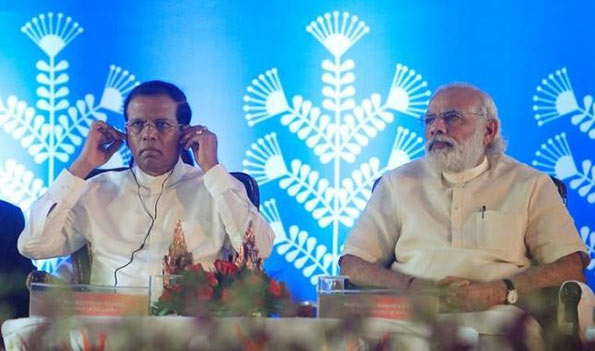Sri Lanka to cancel Indian coal plant deal; proposes LNG instead

Sri Lanka will cancel plans for a 500 megawatt Indian-built coal-fired power plant at its strategic eastern port city of Trincomalee and will instead opt for a liquefied natural gas (LNG) power plant, a cabinet minister said late on Tuesday.
Chandima Weerakkody, Sri Lanka’s petroleum minister, said President Maithripala Sirisena told Indian Prime Minister Narendra Modi of the decision at a meeting on Saturday during Sirisena’s visit to the island nation’s larger neighbour.
“We do not want to hurt India. So President Sirisena in his visit has offered an LNG plant instead of the coal plant,” Weerakkody told Reuters. “This has been discussed at the highest level and there is consensus.”
Sri Lanka is trying to increase its power generation capacity after a recent blackout that was the worst in 20 years, government officials say.
B.M.S. Batagoda, the energy ministry secretary said the switch to LNG was proposed after ten years of opposition to a coal-fired power plant by the residents of Sampur, a village near Trincomalee, where India has already proposed to build South Asia’s largest petroleum hub.
Area residents and environmental groups have resisted the coal power plant ever since it was originally proposed in 2006 due to worries about land clearance and pollution.
Plans for the $500 million coal power plant project were finalised in 2011, when state-run Ceylon Electricity Board (CEB) and India’s state-run National Thermal Power Corporation Ltd (NTPC) agreed to form a joint venture for its construction.
It is not clear which Indian companies would be considered as partners on the proposal to build a gas-fired power plant. Natural gas is a cleaner burning fuel than coal, but there would be the added hurdle that Sri Lanka has no LNG import infrastructure.
Sri Lanka’s only coal-fired power plant with 900 MW capacity was built with a $1.4 billion loan from China in two phases. However, the Chinese plant has faced frequent repairs.
India and China have been increasingly loaning funds to Sri Lanka over the last few years, mainly for infrastructure projects. Since the island’s civil war ended in 2009, the two rivals have been competing for influence in Sri Lanka, which sits right off one of the world’s busiest shipping routes.
(Reuters)

Latest Headlines in Sri Lanka
- IGP Deshabandu Tennakoon’s assets to be frozen if he evades court – Minister March 9, 2025
- Sri Lanka to introduce low-priced alcohol to curb illicit liquor consumption March 9, 2025
- Oddusuddan Tile Factory reopens after 35 years March 9, 2025
- Elephant Pass salt factory to be opened to the public on March 26, 2025 March 9, 2025
- Sri Lanka’s Public Finance Committee approves excise duty hike on liquor March 8, 2025



That is a very good proposal
The cost of a unit from LNG fueled plant will cost over two and a half times of that from a coal fueled plant any one if he loves his country should 1st find out the cost which can be obtained from the Internet as such will any investor invest in Sri Lanka it is the bad false publicity against coal fueled plants that as bias our people against coal fueled plants for its chimneys are 300 meters high and as such any tracers of harmful pollutants are sent into the global atmosphere not to the local atmosphere all developed and developing countries have become rich on coal fueled electricity and over 50% of the world electricity is from coal fueled so is it In India who is attempting to burden us with LNG and our national electricity policy is given by Act No 20 of 2009 which is for least cost electricity the Secretary to the Ministry of Power should go to Malaysia bring a video of a modern coal power station and its surroundings and telecasts it for coal fueled electricity is the one and only least cost electricity that can give a estimated 44 Billion units per year to produce a million jobs in 4 years time